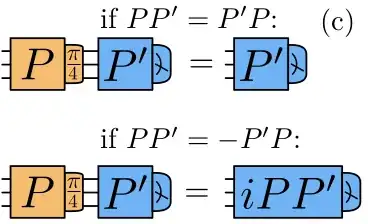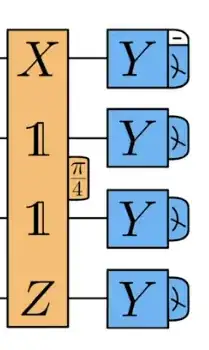First of all, let us consider an arbitrary unitary $U$. If we first apply $U$ and then measure a POVM $\{E_a\}$, then this is equivalent to doing nothing and measuring the POVM $\{U^\dagger E_a U\}$ instead since $\mathrm{Pr}[a|\rho] = \mathrm{tr}\left( E_aU \rho U^\dagger \right) = \mathrm{tr}\left( U^\dagger E_a U \rho \right)$.
In particular, a Pauli measurement is given by the projectors $\frac 1 2 \left( \mathbb{I} \pm P \right)$ and the altered measurement is described by the
Hermitian operator $O = U^\dagger P U$.
Now note that $U=\exp(- i\frac \pi 4 P)$ is a Clifford unitary if $P$ is a Pauli operator. Thus, absorbing the action of $U$ into the measurement of a Pauli operator $Q$ will result in another Pauli measurement of $\pm Q'=U^\dagger Q U$. Note that the possible sign simply relabels the outcomes.
Next, it is clear that $U^\dagger Q U=Q$ if $P$ and $Q$ commute, thus we can remove $U$ from the circuit. If not, a straightforward calculation shows that
$$
e^{i\frac \pi 4 P}Qe^{- i\frac \pi 4 P} = i PQ \equiv \pm Q'.
$$
If you measure the first qubit after a $n$-qubit Clifford gate, than this effectively the same as doing nothing and performing a Pauli measurement on many ($\leq n$) qubits (since $U$ will generally map a Pauli operator on the first qubit to a Pauli operator supported on $n$ qubits).
The measurement in your final example consists of measuring four commuting Pauli operators $P_1,\dots,P_4$ (a syndrome measurement). The projectors of the joint measurement are given as products $P_x = \prod_{i=1}^4 \frac 1 2 (\mathbb I + (-1)^{x_i} P_i)$ where $x\in \{0,1\}^4$. To compute $UP_x U^\dagger$, we can thus individually transform the involved projectors.
Let us use the above reasoning sequentially:
- $X\otimes\mathbb{I}\otimes\mathbb{I}\otimes Z$ anti-commutes with $Y\otimes\mathbb{I}\otimes\mathbb{I}\otimes\mathbb{I}$, thus we can replace the measurement of $-Y$ on the first qubit by the measurement of $-iXY\otimes\mathbb{I}\otimes\mathbb{I}\otimes Z=Z\otimes\mathbb{I}\otimes\mathbb{I}\otimes Z$.
- The Pauli operators on the second and third qubit obviously commute with the unitary, so the measurements are unchanged.
- The last Pauli operator again anti-commutes, so we can replace it by the measurement of $X\otimes\mathbb{I}\otimes\mathbb{I}\otimes i ZY=X\otimes\mathbb{I}\otimes\mathbb{I}\otimes X$.
Note that we obtained an entangling measurement between the first and the fourth qubit. This is in fact a Bell measurement as the joint eigenvectors of $X\otimes X$ and $Z\otimes Z$ are the four Bell states $\{|00\rangle \pm |11\rangle, |01\rangle \pm |10\rangle\}$.

